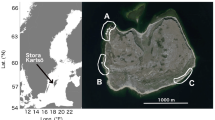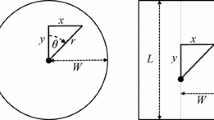Abstract
Mark–resight methods can be a less expensive and less invasive alternative to traditional mark–recapture for estimating abundance and related demographic parameters. This is because only a single marking event is required, and subsequent sighting data from both marked and unmarked individuals are used for estimation. Mark–resight is therefore particularly appealing when working with limited budgets or sensitive species. These methods have been applied to many taxa, including avians such as Bald Eagles (Haliaeetus leucocephalu), Sage Grouse (Centrocercus urophasianus), and New Zealand Robins (Petroica australis). However, previous model and software development overwhelmingly focused on abundance estimation and did not extend much beyond classic Lincoln–Petersen methods. For this purpose, Program NOREMARK provided a convenient, but limited, means for analysis. To address these limitations, a new suite of likelihood-based mark–resight estimators has been developed and implemented within Program MARK. Unlike the estimators in NOREMARK, these new models provide a theoretical basis for model selection and multimodel inference, the incorporation of spatio-temporal and individual covariate information, full utilization of the robust design (including the estimation of survival and state transition probabilities), and all the other analysis tools that MARK provides. In addition, MARK no longer requires that the exact number of marked individuals available for sighting be known, thereby greatly extending the potential use of mark–resight methodology for population monitoring. Here, we provide a review of mark–resight methodology and present the various mark–resight estimators that are implemented in Program MARK.
Similar content being viewed by others
References
Arnason AN, Schwarz CJ, Gerrard JM (1991) Estimating closed population size and number of marked animals from sighting data. J Wildl Manage 55:716–730
Bartmann RM, White GC, Carpenter LH, Garrott RA (1987) Aerial mark-recapture estimates of confined mule deer in pinyon-juniper woodland. J Wildl Manage 51:41–46
Bowden DC, Kufeld RC (1995) Generalized mark-resight population size estimation applied to Colorado moose. J Wildl Manage 59:840–851
Burnham KP, Anderson DR (2002) Model selection and multimodel inference: a practical information-theoretic approach, 2nd edn. Springer, New York
Kendall WL, Nichols JD (2002) Estimating state-transition probabilities for unobservable states using capture-recapture/resighting data. Ecology 83:3276–3284
Kendall WL, Pollock KH, Brownie C (1995) A likelihood-based approach to capture-recapture estimation of demographic parameters under the robust design. Biometrics 51:293–308
Kendall WL, Nichols JD, Hines JE (1997) Estimating temporary emigration using capture-recapture data with Pollock’s robust design. Ecology 78:563–578
McClintock BT, Hoeting JA (2009) Bayesian analysis of abundance for binomial sighting data with unknown number of marked individuals. Environ Ecol Stat doi:https://doi.org/10.1007/s10651-009-0109-0
McClintock BT, White GC (2009) A less field-intensive robust design for estimating demographic parameters with mark-resight data. Ecology 90:313–320
McClintock BT, White GC, Antolin MF, Tripp DW (2009a) Estimating abundance using mark-resight when sampling is with replacement or the number of marked individuals is unknown. Biometrics 65:237–246
McClintock BT, White GC, Burnham KP, Pryde MA (2009b) A generalized mixed effects model of abundance for mark-resight data when sampling is without replacement. In: Thomson DL, Cooch EG, Conroy MJ (eds) Modeling demographic processes in marked populations. Springer, New York, pp 271–289
Miller SD, White GC, Sellers RA, Reynolds HV, Schoen JW, Titus K, Barnes VG, Smith RB, Nelson RR, Ballard WB, Schwartz CC (1997) Brown and black bear density estimation using radiotelemetry and replicated mark-resight techniques. Wildl Monogr 133:1–55
Minta S, Mangel M (1989) A simple population estimate based on simulation for capture-recapture and capture-resight data. Ecology 70:1738–1751
Moa P, Negard A, Overskaug K, Kvam T (2001) Possible effects of the capture event on subsequent space use of Eurasian lynx. Wildl Soc Bull 29:86–90
Neal AK, White GC, Gill RB, Reed DF, Olterman JH (1993) Evaluation of mark-resight model assumptions for estimating mountain sheep numbers. J Wildl Manage 57:436–450
Otis DL, Burnham KP, White GC, Anderson DR (1978) Statistical inference from capture data on closed animal populations. Wildl Monogr 62:1–135
Schwarz G (1978) Estimating the dimension of a model. Ann Stat 6:461–464
Sweitzer RA, Van Vuren D, Gardner IA, Boyce WM, Waithman JD (2000) Estimating sizes of wild pig populations in the north and central coast regions of California. J Wildl Manage 64:531–543
Travaini A, Aldama J, Delibes M (1993) Red fox capture locations in relation to home range boundaries. Mammalia 57:448–451
Walsh DP, White GC, Remington TE, Bowden DC (2004) Evaluation of the lek-count index for greater sage-grouse. Wildl Soc Bull 32:56–68
White GC (1996) NOREMARK: population estimation from mark-resighting surveys. Wildl Soc Bull 24:50–52
White GC (2008) Closed population estimation models and their extensions in Program MARK. Environ Ecol Stat 15:89–99
White GC, Burnham KP (1999) Program MARK: survival estimation from populations of marked individuals. Bird Study 46:120–139
White GC, Shenk TM (2001) Population estimation with radio-marked animals. In: Millspaugh J, Marzluff JM (eds) Radio tracking and animal populations. Academic, San Diego, pp 329–350
White GC, Burnham KP, Anderson DR (2001) Advanced features of Program MARK. In: Field R, Warren RJ, Okarma H, Sievert PR (eds) Wildlife, land, and people: priorities for the 21st century, Proceedings of the Second International Wildlife Management Congress, The Wildlife Society, Bethesda, Maryland, USA, pp 368–377
White GC, Kendall WL, Barker RJ (2006) Multistate survival models and their extensions in Program MARK. J Wildl Manage 70:1521–1529
Author information
Authors and Affiliations
Corresponding author
Additional information
Communicated by M. Schaub.
Appendix
Appendix
For LNE, the expectation and variance formulae for \(T_{u_j}\) are:
and
where
For IELNE, the expectation and variance formulae for \(T_{u_{ij}}\) are:
and
For (Z)PNE, the expectation and variance formulae for \(T_{u_j}\) are:
and
where λj|s = exp(σ 2j /2 + αj).
Rights and permissions
About this article
Cite this article
McClintock, B.T., White, G.C. From NOREMARK to MARK: software for estimating demographic parameters using mark–resight methodology. J Ornithol 152 (Suppl 2), 641–650 (2012). https://doi.org/10.1007/s10336-010-0524-x
Received:
Revised:
Accepted:
Published:
Issue Date:
DOI: https://doi.org/10.1007/s10336-010-0524-x




